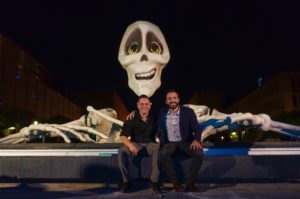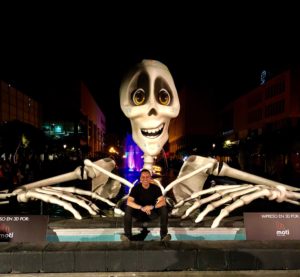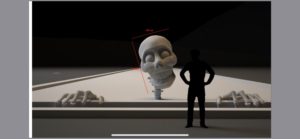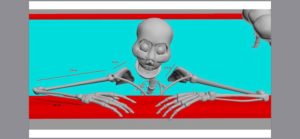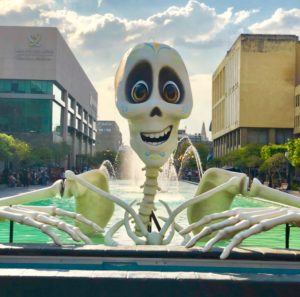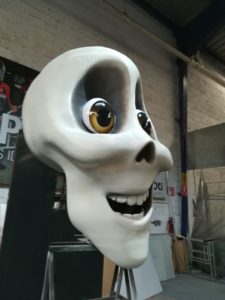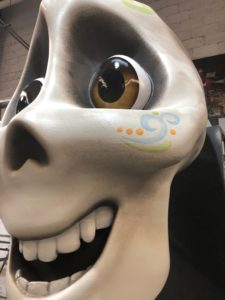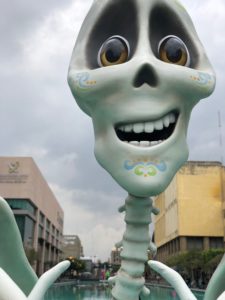While the Day of the Dead has always been somewhat familiar to Americans, it has never been more so than since the release of the Oscar-winning movie Coco. Never have skeletons been more lovable – even when on an enormous scale and emerging from the fountain in the middle of a public plaza as one did this past Valentine’s weekend. This happened as part of Guadalajara, Mexico’s second annual Festival of Lights in which the Plaza Tapatia was transformed into a phosphorescent wonderland to celebrate the 476th anniversary of the city’s founding. Coco is beautifully done and has, rightfully, been heaped with praise and critical acclaim. However, while this particular skeleton is not related to the movie, it is related to the tradition of celebrating the Day of the Dead and could be the starting point for a new tradition of 3D printing on a massive scale in Mexico.
I am living in Guadalajara and had the opportunity to attend the festival this year where, after an exhaustive (and exhausting) search for parking, my family and I found our way into the thick of things. We quickly decided, amidst the press of hundreds of thousands of people, to find our way back out of the thick of things, but not before we got a glimpse of the fantastic skeletal creation by Moti Digital. The statue, aptly named Morti, measuring 27.5 feet wide and 11.8 feet high, provided a smiling backdrop for hundreds of visitors’ photos. The entire project was 3D printed using Moti’s Massivit 1800 3D printer which allowed the company to produce at the large scale necessary.
As I’m so close to the site of its production, I got in touch with the folks at Moti Digital and they kindly agreed to give me a tour of their facilities and talk about their creation with Moti’s Director of Innovation, Gerardo Garcia de Quevedo.
Moti Digital has been in business for 15 years, and since its inception, it has risen to the top of its field, employing more than 200 people to produce large-format 2D and 3D media, signage, and branding materials. In October, Israel-based company Massivit reached out to Moti to see if they would be interested in integrating one of the company’s famously large 3D printers into their workflow. Always looking for new ways to create, the company agreed and went from 3D printing novices to executors of one of the largest 3D prints in the world.
Working together with Massivit and AlteaCorp, the company that produces the Guadalajara Festival of Lights, as well as a team of blacksmiths and carpenters, they turned over 400 pounds of filament into the grinning head and upper torso of the architecturally scaled skeleton. Combine that with a further 700 pounds of internal structure and you can begin to understand the scale of the operation. Garcia de Quevedo explained how it became possible to undertake such a project:
“This project was immediately interesting to us, but the challenge was also very real. Not only was this the first large scale project we would execute on this machine, the expense of creating such a massive creature was astronomical. We couldn’t have done it without the logistical support from both Massivit and Altea, as well as the donation of all of the filament from Massivit. It was exciting then to be working on such an unprecedented project in this collaborative effort between Mexico and Israel to bring Morti to life.”
 Once the 3D printing was complete, an artist from the southern Mexican state of Oaxaca spent three days painting the prints and bringing them to life. While it might first seem that there are vast areas that could be left white, this is not the case as bones aren’t actually bright white and of a homogenous color. In addition to giving the bones their painted texture, the artist created the gleaming eyes and facial decorations in what might be the world’s largest makeover.
Once the 3D printing was complete, an artist from the southern Mexican state of Oaxaca spent three days painting the prints and bringing them to life. While it might first seem that there are vast areas that could be left white, this is not the case as bones aren’t actually bright white and of a homogenous color. In addition to giving the bones their painted texture, the artist created the gleaming eyes and facial decorations in what might be the world’s largest makeover.
3D printing began on January 8 and the team of 10 people involved had Morti ready for installation by the 10th of February, with a total active printing time of 200 hours, a breathtakingly short period of time when you consider the enormous scale of the project. The compressed time line for fabrication was only possible because of the use of 3D printing and speaks volumes [sorry, pun intended] about its potential to realize other projects of this scope, as Moti hopes to continually use their giant 3D printer to create objects outside of the realm of the ordinary. In total, they created 34 pieces which then had to be assembled using an internal support structure made of iron, a skeleton inside of a skeleton. Garcia de Quevedo described one of the nerve-wracking moments in the process of creation:
“The bone, the radius bone in the arm, cracked after it was printed. This was a moment when your heart stops, but you have to keep working and so we simply didn’t let it stop us. We had a deadline, a very short deadline and there was no time to mope about because of that accident. After that, there were really no other problems, just hard work and learning as you go.”
The idea for the skeleton itself was proposed by Altea because they are planning to open a theme park in October of 2018 that will be based in the imagery and ideas associated with the Day of the Dead. In the time since Morti was introduced to the public at the Festival of Lights, he has been packed away, awaiting his installation at their park, which will be used for events such as light shows, performance art, and exhibitions all centered on the Day of the Dead. Once Morti is rebuilt, the plan is that he will be joined at his new location by other gargantuan 3D printed figures.
The team at Moti has already begun work on other projects that will require the scale of the Massivit 3D printer in order to bring to fruition, such as a model of a WWII fighter plane that will hang as part of the decor of a popular casual dining establishment in Guadalajara.
What do you think of this news? Let us know your thoughts; join the discussion of this and other 3D printing topics at 3DPrintBoard.com.
SaveSave
Subscribe to Our Email Newsletter
Stay up-to-date on all the latest news from the 3D printing industry and receive information and offers from third party vendors.
You May Also Like
3D Printing Unpeeled: New Arkema Material for HP, Saddle and Macro MEMS
A new Arkema material for MJF is said to reduce costs per part by up to 25% and have an 85% reusability ratio. HP 3D HR PA 12 S has been...
3D Printing News Briefs, January 20, 2024: FDM, LPBF, Underwater 3D Printer, Racing, & More
We’re starting off with a process certification in today’s 3D Printing News Briefs, and then moving on to research about solute trapping, laser powder bed fusion, and then moving on...
3D Printing Webinar and Event Roundup: December 3, 2023
We’ve got plenty of events and webinars coming up for you this week! Quickparts is having a Manufacturing Roadshow, America Makes is holding a Member Town Hall, Stratafest makes two...
Formnext 2023 Day Three: Slam Dunk
I’m high—high on trade show. I’ve met numerous new faces and reconnected with old friends, creating an absolutely wonderful atmosphere. The excitement is palpable over several emerging developments. The high...






